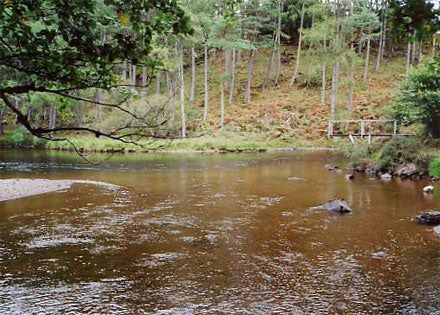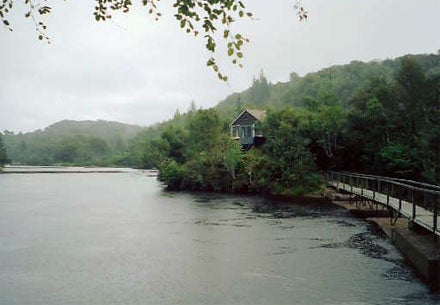| The Inver Salmon are a migratory fish and salmon fishing is dependent upon there being fish in the river. Rivers have their seasons when there are very few fish in the river and, at other times of the year, many fish come in from the sea on their travels to the breeding grounds. Some rivers fish very well in the springtime and very poorly later in the year whereas others have little or no fish in them until the summer months or even well into autumn. A further important factor is the amount of water in the river. I’ve been to the same river at potentially good times of the year and been dismayed to find that it had not rained for several weeks and water levels were too low to encourage salmon to swim upstream. Last year I fished the River Kirkaig in Sutherland after two weeks of torrential rain and the surging river made fishing just about impossible. Late this September I fished the neighbouring River Inver and conditions were just about right with recent rain but no flooding and an overcast day with a little sunshine. The Inver flows out of Loch Assynt and water levels are governed by the amount of rainfall in the surrounding mountains. The Inver is only about six miles long with a rapid series of waterfalls in the last half mile as the river rushes down to the sea at Lochinver. The river is beautifully kept by the local estate owners, the Inverlodge Hotel and the local angling association. Artificial weirs were constructed years ago, fishing platforms conveniently built and the trees, undergrowth and bank side drainage is ‘managed’ without being obvious and intrusive. Walking the beat I walked the river (again) armed with the print-out from the hotel and identified the pools and the popular lies and tried to work out how to cast to where the fish were likely to be. The walk in itself is an experience. Like many Scottish rivers, the Inver is in a pleasing, remote setting for much of its length, though access for cars brings the angler to within a couple of strides of the river. The flora and fauna constantly changes and surprises but always delights the eye. I always think it is worth finding the local fishermen’s bar prior to a day on an unknown river and, on the previous evening I talked to two regulars (one had the registration “S4LMO” on his four wheel drive). They advised me to try the upper end of the beat and then work my way downstream: best chances of a fish, they reckoned, were upstream, even though this involved a three miles each way hike. This called for boots rather than waders and, in all honesty I only noted two lies in the whole of the lower beat where waders would have been required. I also noted that I was the only angler on this three mile stretch of prime salmon river. Long Pool and Whirl Pool I started on the Long Pool but found that I was in an exposed location and had a driving wind whistling over my right shoulder that interfered with casting and would not allow an easy cast across and upstream. I moved down a couple of hundred yards to Whirl Pool. This was aptly named, for an adjutting bank opposite created a huge area of swirling water in mid river. It was narrow enough to cast across the whirlpool and into the main current which ran along the far bank from me.
I was using a 12 foot Daiwa rod and I started with a 10 weight floating line and a Highlander but the flow kept the fly either on the surface or did not allow it to sink more than a couple of inches. I switched to a sink tip and upped the size of the fly at the same time. Several fish had appeared in the last few minutes as if there was a convoy of fresh run salmon on its way upstream. Taking the backing off On my third cast, as the line travelled into the faster water at the far side of the whirlpool, I felt a nudge on the line followed by a slack and then a hard pull. The fish had hooked itself with my reactions functioning about five seconds slower than the hooked salmon. The fish went upstream quickly then doubled back and went down heading for the next pool. I was soon down to the backing in only several seconds and beginning to panic. I tried to push the clutch up a bit and use my hand to slow the line. I estimated that the fish took almost the whole 100M of backing before it stopped. I could not bring it back to me so I set off down stream to find the fish winding in all the time. At last, I saw my quarry about twenty yards away and started to reel in harder thinking I had the upper hand. I held hard whilst finding a suitable spot to get the net under it and, in that split second, the line went lifeless and the fish was away with the fly still in its mouth and a 10 lbs leader frayed through at the hook knot.
I should think it weighed about eight pounds but felt like a rugby player at the other end of the line. However, it was a sporting fish for it did not tell its mates and, returning to the pool, I had another two fish. Neither fought quite as well as the escapee and I was more prepared: two hen fish between six and eight pounds and both returned to the river to spawn. Kill or release? Until recent times many anglers killed most of the salmon they netted but not any more. I have found in recent years that most anglers returned every fish and a few only kill the occasional one for the table. Compared to ten years ago I think this trend is partly responsible for an increase in fish number in this part of Scotland. I have none but anecdotal evidence for this but it’s a change for the better and there seems to be more salmon in the rivers of the far north-west. Contact for salmon and trout fishing on the Kirkaig and Inver rivers Recommended Flies: (Dull conditions) – Willie Gunn, Black Doctor, Green Highlander, Ally’s Shrimp. (Bright conditions) – Blue Doctor, Blue Charm and Yellow Torrish. |
Welcome!Log into your account















